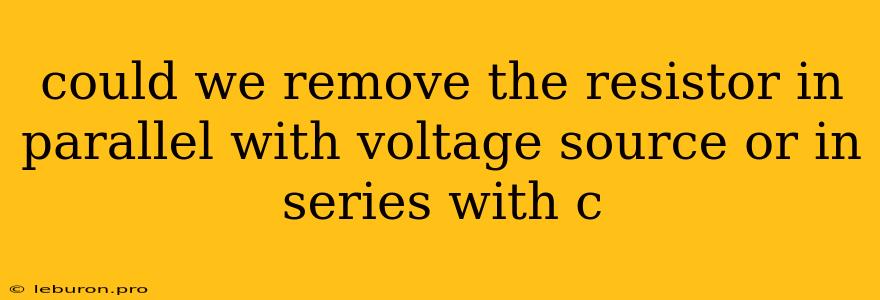The presence of resistors in circuits alongside voltage sources and capacitors can significantly impact circuit behavior. While it's tempting to simplify circuits by removing resistors, understanding the implications of such actions is crucial. This article delves into the effects of removing resistors in parallel with voltage sources and in series with capacitors, providing insights into the potential consequences and guiding you towards informed circuit design decisions.
Resistors in Parallel with Voltage Sources
A resistor placed in parallel with a voltage source might seem redundant at first glance. After all, the voltage source itself dictates the voltage across the resistor. However, removing the resistor in such a scenario can have unintended consequences.
Impact on Current Flow
-
Increased Current: The resistor acts as a current limiting element. Without it, the current drawn from the voltage source can increase significantly. This increase might overload the source or components connected to the circuit, potentially leading to damage.
-
Short Circuit: In extreme cases, removing the resistor could create a short circuit. This occurs when the resistance path between the positive and negative terminals of the voltage source is minimized, resulting in a sudden and potentially hazardous surge of current.
Voltage Source Considerations
-
Internal Resistance: Every voltage source has an internal resistance. When the external resistor is removed, the internal resistance becomes the only limiting factor for the current. Depending on the source's internal resistance and its current rating, the increased current might exceed the source's capacity.
-
Voltage Stability: Removing the parallel resistor can affect the stability of the voltage source. The source might struggle to maintain a constant output voltage under the increased current demand.
Practical Examples
-
Power Supply: In a power supply circuit, a resistor placed in parallel with the output voltage acts as a safety measure, preventing excessive current flow in case of a short circuit. Removing this resistor can lead to catastrophic failure of the power supply.
-
Load Protection: A parallel resistor can protect a load by limiting the current it draws from the voltage source. Removing it can expose the load to potentially damaging currents.
Resistors in Series with Capacitors
Resistors in series with capacitors play a crucial role in circuit behavior, and removing them can have significant implications on charging and discharging processes.
Charging Time Constant
-
Increased Charging Time: The time it takes for a capacitor to charge is directly proportional to the resistance in the series circuit. Removing the resistor effectively eliminates the resistance, resulting in a significantly shorter charging time constant. This rapid charging can stress the capacitor and potentially cause damage.
-
Uncontrolled Charging: Without the resistor, the capacitor will charge instantly. This rapid charging might not be controlled, leading to voltage spikes that can disrupt circuit operation.
Discharging Time Constant
-
Reduced Discharging Time: The resistor also influences the capacitor's discharge time. Removing it will lead to a significantly faster discharge, potentially causing unexpected behavior in circuits relying on the capacitor's stored energy.
-
Discharge Current: Without the resistor, the discharge current will be limited only by the capacitor's internal resistance. This can lead to excessive current flow, potentially causing damage to the capacitor or other circuit components.
Practical Applications
-
Timer Circuits: Resistors are crucial in timer circuits where the capacitor's charging and discharging time determine the duration of the timer. Removing the resistor will completely alter the timer's behavior.
-
Filtering Circuits: In filter circuits, the resistor and capacitor combination acts as a frequency-dependent filter. Removing the resistor will disrupt the filtering effect, potentially allowing unwanted frequencies into the circuit.
Conclusion
While removing resistors might seem like a simple simplification, it can significantly impact circuit behavior. Resistors placed in parallel with voltage sources limit current flow, protect against short circuits, and contribute to voltage stability. Resistors in series with capacitors control charging and discharging time constants, ensuring controlled circuit operation. Removing these resistors can lead to increased current, uncontrolled charging and discharging, voltage spikes, and potentially catastrophic circuit damage. Understanding the role of resistors in these scenarios is critical for safe and effective circuit design.
